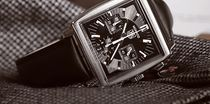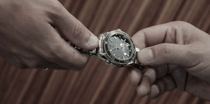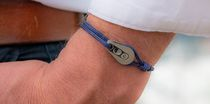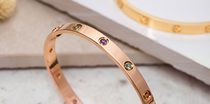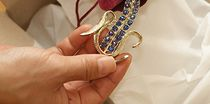Clear all filters
All our Earrings jewel
Earings
4 items
Earrings, a long history of humanity
Jade stone and half-circle earrings, small gold rings worked by granulation or embossing, disc-shaped earrings decorated with the interrasilic opus technique... Are we talking about jewelry collections from the Place Vendôme? Well, not at all. The earrings described have sublimated the face of women respectively in Inner Mongolia (China) 8000 years BC, in Mesopotamia in the Bronze Age and in the Etruscan civilization of the 6th century BC. The history of earrings, the jewel that today is the most worn by women, is as old as the world. They are also witnesses of ancestral know-how in the work of gold. Roman women displayed their social standing by wearing bell earrings - crotalia - or delta earrings adorned with pendants. At the same time, the Persians of the Parthian Empire developed their mastery of the precious metal by skilfully working the shapes of their earrings. And yet, despite these promising beginnings, the earring fell into oblivion in the West with the fall of the Roman Empire. It was not even until the Renaissance that it regained its credentials. Earrings reappeared in Italy in the form of a ring adorned with a pearl, and then the fashion shifted to girandoles - in the form of a three-branched candlestick with three drop-shaped stones attached to it - and then to pendreloques - with a single pear-shaped pendant - models that are still common to us today. The drop shape, in particular, is found a lot in vintage earrings.
Women of character and creative jewelers
As the French Revolution also shook up jewelry traditions, it signed the advent of less ostentatious, flatter and thinner earrings, the poissardes, nonetheless adorned with glass or enamel for the most elaborate of them. Demonstrative jewelry made a comeback under Napoleon I, but the voluminous earrings would be particularly promoted by a woman, Queen Victoria. In the 1830s the birth of the repoussé style, where gold leaf is worked by embossing, makes these jewelry lighter. That said, across the Channel, the Victorian period is more about the ostentatious earring, with long dangles, adorned with all sorts of patterns, stones, cameos. From the gold rings of antiquity to the pendants of the Renaissance and the 19th century, the different types of earrings were thus already well marked before the contemporary period. We can even add the creoles, which, remember, were worn by slaves in the New World to signify their belonging to their homeland. But it was not until the early twentieth century that ear chips appeared that seemed to float on the lobe: in the United States, the Gibson Girls and their raised hair popularized the top and drop, then consisting of a simple stone or a pearl. France, however, did not leave the Americans the privilege of creativity, far from it. After all, isn't Paris already the capital of fashion and luxury? The jeweler-watchmaker Louis Cartier - to whom we already owe the Santos Dumont aviator's watch - gave birth to the garland style in 1910, working the settings on platinum and no longer exclusively on gold. The great houses of Place Vendôme and elsewhere multiplied, moreover, at the same time the materials and shapes, which became more geometric in the Art Deco period. The appearance of large earrings is favored by the fashion of short hairstyles, Van Cleef & Arpels invents the invisible setting, the import of jade stone, rock crystal and coral multiplies the possibilities.
At the time of the monobuckle and the ear cuff
The contemporary history of earrings is therefore primarily linked to fashions, to the evolution of society. Even ear piercing is subject to these trends, forgotten in the 1930s with the appearance of the clip-on clasp, then in the 1950s, back twenty years later thanks to dedicated equipment ... Side curls, the extravagant dimensions of the 1960s (marked by the advent of costume jewelry) give way to ear studs in the following decades, which are also appropriated by men. This is actually the road to democratization as we know it since the early 2000s. The piercing in particular opens new possibilities. The earring can be completed by the earring jewel worn on the helix or in "Industrial" - a bar that crosses the ear. Many of the luxury Houses are actually developing precious gold ear jewelry and in any case setting the trends or following them. The monobuckle has become commonplace at a time when wearing mismatched, asymmetrical or accumulated earrings is becoming a style statement. And this while a new trend has emerged, that of the ear cuff, literally the ear cuff. Jewelers like Fred, Dinh Van, Dior or Louis Vuitton, among other examples, have already jumped on this new wave.


